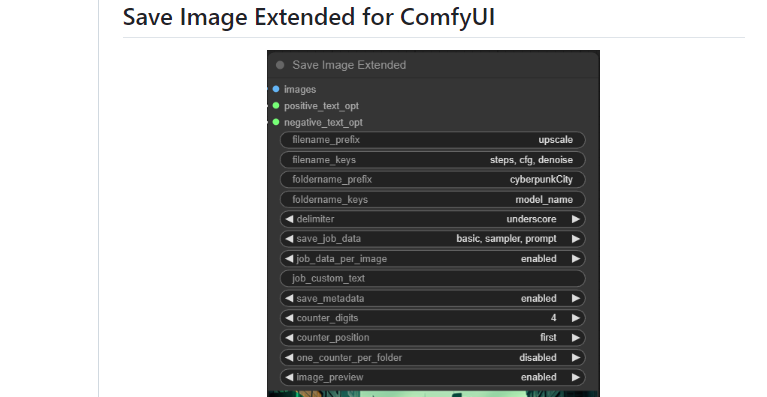FF Saving Images ComfyUI,Alright, let’s talk about saving images in ComfyUI. If you’re like me, you’ve probably been through a whirlwind of image editors and tools, each promising to make life easier but somehow only making things slightly more frustrating. And then there’s ComfyUI—a handy little tool that’s, well, comfy, once you get the hang of it. But saving images? Yeah, I know. It sounds easy, but there are a few quirks you’ll want to watch out for.
Before you roll your eyes and think, “It’s just saving an image, how complicated can it be?”—I’ve been there too, my friend. Let’s break this down so we can save our precious work with minimal stress and maybe even enjoy the process. Here’s how to navigate the wonderful (and sometimes weird) world of saving images in ComfyUI.
The First Steps: Setting Up ComfyUI
Let’s assume you’ve already got ComfyUI up and running. If not, well, you’ve got a whole other battle ahead of you, but don’t worry, it’s not too bad. For now, I’m going to focus on the image-saving part, which is where most of us get tripped up anyway.
FF Saving Images ComfyUI
Now, once you’ve edited, played around with the filters, and gotten your image looking all artsy (or whatever you’re going for), you’re probably thinking, “Cool, let’s save this masterpiece!” That’s where the real fun begins.
Saving Your Image: The Basics
The basics of saving in ComfyUI are pretty straightforward. You just hit “Save,” right? Well, yes. But also no. Let me explain.FF Saving Images ComfyUI.
Once you’ve made all the edits and you’re happy with your work, you’ll notice a little “Save” button hanging out somewhere in the corner. It looks all innocent, but depending on how deep you are in the process, pressing it might result in a bit of an anticlimax. You hit it, and nothing seems to happen. Or maybe something happens, but you can’t find the file anywhere.
FF Saving Images ComfyUI
This is usually where I start frantically clicking through my folders, mumbling under my breath, wondering if my computer is playing a prank on me. But it’s not your computer’s fault (this time). It’s just that ComfyUI, in all its brilliance, can sometimes be a bit sneaky about where it’s saving your files.
File Locations: The Hunt Begins
Here’s the thing: ComfyUI might not always save your images in the most obvious place. It defaults to a folder that’s probably deep within the labyrinth of your directory. Finding it can feel like you’re on a treasure hunt, but without the fun treasure at the end—just a JPEG.
What you want to do is check your default settings. There’s usually a designated folder for saved images, but it’s not always where you think. On Windows, for instance, it might be in the depths of your AppData folder. On Mac, well, I won’t pretend it’s any easier. Sometimes, I’ve found that ComfyUI prefers to hide things away in a Documents folder, but hey, your guess is as good as mine.
Once you locate that folder (I hope you have better luck than I did the first time), you’ll want to bookmark it or pin it to your quick access because trust me, you don’t want to go through that little scavenger hunt every time you save an image.
File Naming: Oh, It Matters!FF Saving Images ComfyUI
Alright, so now that we’ve figured out where our images are being saved, let’s talk about file naming. Here’s where things can get a little chaotic if you’re not careful. ComfyUI might spit out files with names that look like someone randomly smashed their keyboard—tons of numbers, symbols, and maybe a letter or two if you’re lucky. If you’re trying to find that one amazing image you saved three days ago, good luck.
Here’s a pro tip: manually name your files before you hit that save button. It’ll save you a lot of future headaches. Give your files meaningful names like “sunset_edit_v2” or “cat_with_hat” (hey, whatever floats your boat). Just make sure you know what’s what, especially if you’re saving multiple versions of the same image.
You can rename the file either when you save it or after it’s saved (but only if you know where it is—refer to the previous section). I can’t stress enough how much easier this makes things, especially if you’re someone who tends to create a lot of versions while tweaking an image.
File Formats: JPEG, PNG, or Something Fancy?
Another thing to keep in mind is file formats. ComfyUI is pretty flexible, but it does have its quirks. You’ve got your usual suspects like JPEG and PNG, but depending on the kind of work you’re doing, you might want something a bit more fancy, like TIFF or even PSD for those deeper edits that need to be revisited later.
Choosing the right file format matters more than you think. If you’re saving an image with lots of detail and you want to maintain that quality (hello, high-res photographers), go for PNG. It’s lossless, which basically means it doesn’t lose quality every time you save and reopen it.
But if you’re like me and sometimes you just want a quick, lightweight file to share on social media or send to a friend, JPEG will do the job. It compresses the image, which makes the file size smaller but at the cost of some quality. If you don’t mind a little compression, it’s the fastest and easiest way to go.
The Occasional Save Glitch (Because What’s Life Without a Few Tech Problems?)
Let’s get real for a second. Sometimes, even when you do everything right, things just don’t work out. I’ve had a few moments where ComfyUI just refused to save my image—no reason, no error message, just silent defiance.
When this happens, don’t panic. Well, maybe panic a little if you didn’t hit the save button before everything crashed. But more often than not, a quick restart of the program or a reboot of your computer will do the trick. And always—always—keep an eye on those autosave settings, if ComfyUI offers them. Nothing’s worse than losing an hour of work because you trusted your software too much. We’ve all been there, right?
Backups: A Lifesaver (Literally)
Speaking of losing work, let’s talk about backups. I’m not going to pretend I’m the most diligent person when it comes to this, but ComfyUI gives you options to save backup copies of your work. This is especially useful if you’re making a lot of major edits and want to preserve the original image, just in case.
Saving a backup version or a “work in progress” copy will save you from the horror of accidentally overwriting something important. We’ve all hit that save button a little too quickly, only to realize we’ve wiped out an earlier version we actually liked better. So, take a breath, and save multiple versions if you’re doing serious editing.
Final Thoughts: Embrace the Quirks
Look, no program is perfect, and ComfyUI is no exception. Saving images might seem like the simplest thing in the world, but even the best tools have their little quirks. Once you’ve got the basics down—like knowing where your files are actually going, making sure they’re named properly, and picking the right format—ComfyUI becomes a lot more fun to work with.
At the end of the day, it’s all about finding the workflow that suits you. If you love ComfyUI’s simplicity, embrace it. If the file saving process makes you want to throw your computer out the window, well, take a deep breath and remember: it’s probably just hiding that file somewhere weird.



